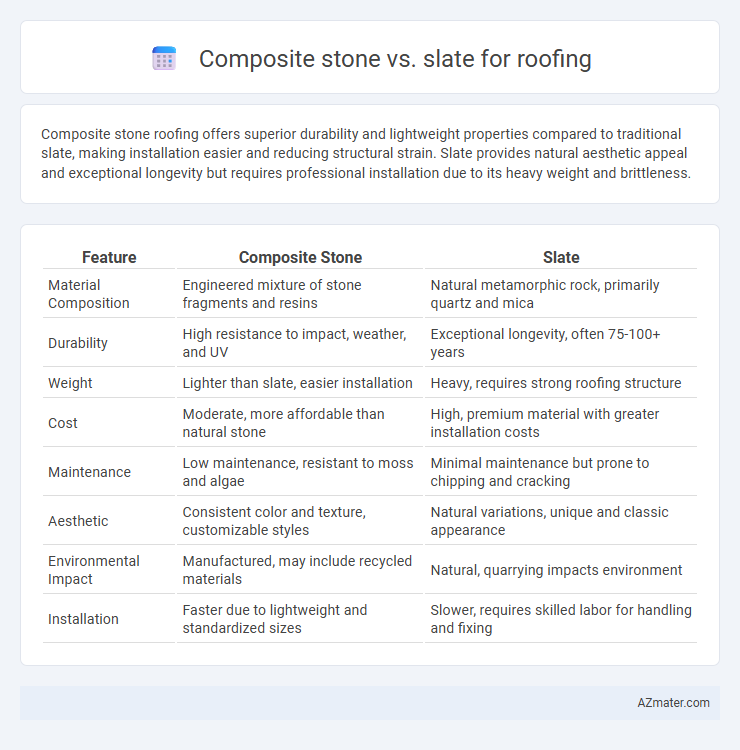Composite stone roofing offers superior durability and lightweight properties compared to traditional slate, making installation easier and reducing structural strain. Slate provides natural aesthetic appeal and exceptional longevity but requires professional installation due to its heavy weight and brittleness.
Table of Comparison
| Feature | Composite Stone | Slate |
|---|---|---|
| Material Composition | Engineered mixture of stone fragments and resins | Natural metamorphic rock, primarily quartz and mica |
| Durability | High resistance to impact, weather, and UV | Exceptional longevity, often 75-100+ years |
| Weight | Lighter than slate, easier installation | Heavy, requires strong roofing structure |
| Cost | Moderate, more affordable than natural stone | High, premium material with greater installation costs |
| Maintenance | Low maintenance, resistant to moss and algae | Minimal maintenance but prone to chipping and cracking |
| Aesthetic | Consistent color and texture, customizable styles | Natural variations, unique and classic appearance |
| Environmental Impact | Manufactured, may include recycled materials | Natural, quarrying impacts environment |
| Installation | Faster due to lightweight and standardized sizes | Slower, requires skilled labor for handling and fixing |
Introduction to Composite Stone and Slate Roofing
Composite stone roofing combines engineered materials such as resin, crushed stone, and fiberglass to create durable, lightweight, and low-maintenance roofing solutions. Slate roofing, made from natural metamorphic rock, offers exceptional longevity, fire resistance, and an elegant appearance but requires professional installation due to its weight and fragility. Both roofing types provide strong weather resistance and aesthetic appeal, making them popular choices for residential and commercial buildings.
Material Composition and Properties
Composite stone roofing combines crushed natural stone bonded with resin, offering enhanced durability, lightweight structure, and resistance to cracking compared to traditional materials. Slate roofing consists of natural metamorphic rock known for its exceptional longevity, fire resistance, and distinctive aesthetic, though it is significantly heavier and more brittle. The choice between composite stone and slate hinges on factors such as weight tolerance of the roof, desired lifespan, and maintenance requirements.
Durability and Longevity Comparison
Composite stone roofing combines synthetic materials with natural stone chips, offering enhanced impact resistance and weather durability compared to traditional slate. Slate roofs, known for their natural beauty and longevity, typically last over 100 years but are prone to cracking under heavy impact or severe weather conditions. Composite stone provides a durable alternative with a lifespan of 50-70 years, requiring less maintenance and better resistance to indoor moisture and freeze-thaw cycles.
Aesthetic Appeal and Design Options
Composite stone roofing offers a wide range of colors and textures, allowing for versatile aesthetic customization that can mimic natural materials like slate or wood. Slate roofing provides a timeless, elegant appearance with unique, natural variations in color and texture, enhancing the visual depth and character of roofs. Both options support sophisticated architectural designs, but composite stone excels in offering more uniformity and design flexibility for diverse roof styles.
Installation Process and Requirements
Composite stone roofing offers a lighter material weight compared to slate, simplifying the installation process and reducing structural support requirements. Slate tiles require skilled labor due to their brittleness and heavier weight, demanding reinforced roof framing and specialized cutting tools for precise fitting. Composite stone roofs typically install faster with standard roofing nails and underlayment, while slate necessitates slate hooks, nails, and meticulous alignment for durable weatherproofing.
Environmental Impact and Sustainability
Composite stone roofing offers improved environmental sustainability due to its use of recycled materials and longer lifespan, reducing landfill waste and raw material extraction compared to slate. Slate, a natural stone, is highly durable and recyclable but involves energy-intensive quarrying and transportation, contributing to a larger carbon footprint. The choice between composite stone and slate roofing hinges on balancing immediate environmental costs with long-term sustainability benefits, where composite options often provide lower embodied energy and enhanced recyclability.
Weight and Structural Considerations
Composite stone roofing typically weighs between 150 to 200 pounds per square, significantly lighter than natural slate, which can range from 800 to 1,500 pounds per square. The reduced weight of composite stone minimizes structural load, allowing installation on buildings with lower load-bearing capacity or older frameworks without extensive reinforcement. Slate's heavy mass demands stronger structural support, often increasing construction costs and complicating retrofitting projects.
Maintenance and Repair Needs
Composite stone roofing offers lower maintenance requirements compared to slate due to its durable synthetic materials that resist cracking, chipping, and weathering over time. Slate roofs demand specialized upkeep, including regular inspections to replace broken or slipped tiles and potential professional cleaning to prevent moss or algae growth, which can be costly. Repairing composite stone roofs is generally faster and less expensive since individual panels are lighter and easier to handle, whereas slate repairs require skilled labor and matching natural stone for seamless integration.
Cost Analysis: Upfront and Long-term
Composite stone roofing typically costs between $7 to $12 per square foot upfront, offering a budget-friendly option compared to natural slate, which ranges from $15 to $30 per square foot due to higher material and installation expenses. Long-term, composite stone requires less maintenance and has a lifespan of 30 to 50 years, significantly reducing replacement and repair costs in contrast to slate, which although durable with a lifespan of 75 to 100 years, involves costly repairs and skilled labor. Factoring in both initial investment and maintenance expenses, composite stone presents a more economical choice for homeowners prioritizing cost-efficiency without sacrificing durability.
Choosing the Right Roofing Material for Your Home
Composite stone roofing offers durability, lightweight installation, and low maintenance, making it ideal for homeowners seeking a cost-effective yet long-lasting option. Slate roofing provides unmatched natural beauty, exceptional fire resistance, and a lifespan exceeding 100 years, appealing to those prioritizing aesthetics and longevity. Assess regional climate, budget, and architectural style to determine whether composite stone's versatility or slate's premium quality best suits your home's roofing needs.

Infographic: Composite stone vs Slate for Roofing
 azmater.com
azmater.com